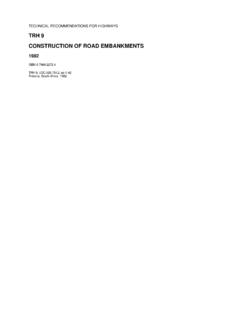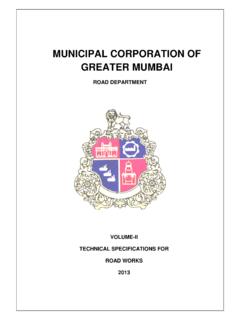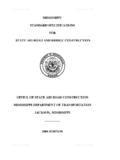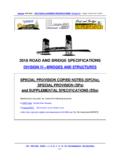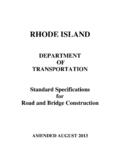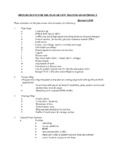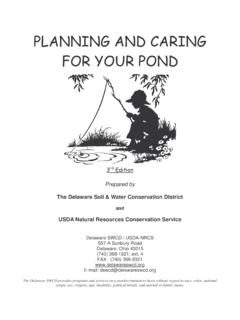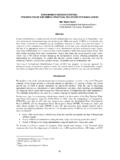Transcription of Technical Information Styropor 800 - Geo
1 1 GeneralThe main consideration when con-structing roads on poor load-bear-ing subsoil is that every load deformsthe soft soil layers; and the greaterthe load, the greater the deforma-tion. This deformation process con-tinues over years, depending on thethickness of the soil layers. The lowshear resistance of poor loadbear-ing subsoils means that concen-trated loads should be avoided asfar as possible, otherwise theselayers will give at the sides. Com-pensating for this form of subsi-dence by laying new material leadsto further settlement due to theadditional conventional techniques of sub-soil improvement by complete orpartial replacement of the soil areoften time consuming and thereforecostly. By employing lightweightmaterials, the weight of the roadembankment and with it the loadon the subsoil is reduced largely subsidence-free method ofconstruction is thus obtained whenpractically no additional loads arebrought to bear ie, by usingextremely lightweight materials inthe embankment such as blocks ofStyropor foam (see figs.)
2 1 and 2). Technical Information24558 June 1991/September 1993 StyroporT800 Highway construction/Ground insulationFoamsStyropor foam as a lightweight construction materialfor road base-courses = Registered trademark 0 1 > 10 Conventional embankment structureincreased surface pressure 0 EPS embankment structurenon increased surface pressure 1~G = G = = 2~110~G1G2 Fig. 1 Comparison of conventional and EPS embankment Experience to dateExperience with Styropor (EPS)foam boards used as frost protec-tion for roads and railways formedthe basis for the development of this construction technique. Thismethod of construction has beenapplied since the middle of the1960s, mainly in countries withsevere winters (eg, alpine regions,Canada and the Scandinavian coun-tries) where the deeply penetratingground frosts make it necessary toprovide costly frostproof subbasesfor roads and railways (see figs. 3and 4).
3 With the appearance in 1984of a booklet Road surfacing withthermal insulation layers made fromfoam plastics by the German Insti-tute for Road & Transport Research(Soil Mechanics Working Group), antifrost construction methods can now be ranked alongside otherconventional construction v H v HWith the EPS method no horizontal forces act on the bridge abutmentand supporting walls (lighter design)Fig. 2 Fig. 3 and 4 Frost protection in road and railway construction using EPS rigid foam use of rigid EPS foam, not onlyfor protective antifrost layers in theform of insulating boards, but as aload-carrying substructure for roadsand bridge abutments in the form oflarge blocks, is based on this practi-cal experience and on the fact thatlightweight (ca. 20 kg/m3) Styroporfoam possesses high bending andshear strength for distributing bothdead weight and live loads; and sooffers higher efficiency than conven-tional building materials (fig.)
4 5). EconomyThe price of rigid EPS is much lowerthan that of other foam materials,but compared with conventionalmaterials used in road substruc-tures, it is considerably more expen-sive. However, a simple cost com-parison is not enough the alterna-tive construction methods must bealso considered. Dependent uponthe local conditions, constructingwith Styropor offers a definite tech-nical and economically interestingsolution mostly for existing struc-tures (eg, bridges, supporting walls,pipe ducts) where subsidence is tobe avoided. Experience from abroadhas shown that in certain cases acost reduction of 50 % can beachieved over conventional buildingtechniques. Styropor also offersobvious advantages if, for instance,material has to be transported tothe construction site over long dis-tances or special conditions have tobe met on environmental Styropor rigid EPSEPS is the standard abbreviation forExpanded Polystyrene.
5 The stan-dard used for rigid EPS foam as aninsulating material in the buildingand construction industry is DIN 18164, part 1. Styropor EPS foamhas been produced worldwide forover 40 years, and is mainly used inthe construction and with the Styropor granulate,which contains a blowing agent, themanufacture of EPS foam takesplace in three stages: Pre-expand-ing, intermediate storage andmoulding(fig 6). During the firststage the granulate is heated andmade to expand rather like pop-corn when it is made (fig. 7). Theblowing agent used is pentane, anaturally occurring pentane expands the Styroporgranules into individual foam parti-cles five times their original , the pre-expanded material isstored to allow air to diffuse into itand the blowing agent partly to dif-fuse out. Finally, the pre-expandedmaterial is placed in a mould andfurther expanded so that the foamparticles fuse together. The result isa compacted foam material whosevolume consists mostly of airtrapped in many microscopicallysized special manufacturing processmakes it possible to vary the densityof the Styropor foam.
6 Because theproperties of the material largelydepend on its density, the foam canbe made with application-specificproperties: from insulating boards tolightweight construction 5 Construction of an embankment using EPS (Hardinxveld-Giessendam, NL).Fig. 6 The processing stages in the production of EPS foam: raw material(left), pre-expanded particles, moulded ProductionStyrene withadditivesWaterBlowing agent(pentane)PolymerizationWaterStyropo rDeliveryto thecustomerSteamStyroporraw materialPre-expandSteamTransport screwMouldSteamSteamIntermediatestorageS tyropor foamFig. 7 Table 1 The most important physical properties of Styropor foamPhysical propertiesTest standardUnitTest resultApplication typesPartPS 15 SEPS 20 SEPS 30 SEApplication typesDIN 18 164, Part 1 WWDWS + WDMinimum densityDIN 53 420kg/m3152030 Building material classDIN 4102B 1, difficultlyB 1, difficultly B 1, difficultlyflammableflammableflammableTh ermal conductivityMeasured value at + 10 CDIN 52 612W/(m K) value according to DIN 4108W/(m K) stress at10% compressive strainDIN 53 421N/mm2* to sustained compressive loads at < 2% strengthDIN 53 423 strengthDIN 53 427 strengthDIN 53 430 of elasticity (compressive tests)
7 DIN 53 457 temperatureshort-termbased on DIN 53 424 C100100100long-term at 5000 N/m2based on DIN 18 164 C80 8580 8580 85long-term at 20000 N/m2based on DIN 18 164 C75 8080 8580 85 Coefficient of linear expansion1/K5 7 10 55 7 10 55 7 10 5 Specific heat capacityDIN 4108J/(kg K)121012101210 Water absorption when kept under water (percent by volume)After 7 daysDIN 53 434% 28 days% vapor diffusion current densityDIN 52 615g/(m2 d)403520 Water vapor diffusion resistance coefficient. 120/5030/7040/100 Design value as specified in DIN 4108.* 1 MPa =1 N/mm2 Table 2 Resistance of Styropor foam to chemical agentsChemical agentStyropor P + FSalt solution (sea water)+Soaps solution and wetting agents+Bleach agents, such as hypochlorite, chlorine water, hydrogen peroxide+Dilute acids+36% hydrochloric acid, 50% nitric acid+Anhydrous acids (eg, fuming sulfuric acid, glacial acetic acid) Sodium hydroxide, potassium hydroxide and ammonia solutions+Organic solventssuch as acetone, ethyl acetone, benzene, xylene, paint thinner, trichloroethylene Saturated aliphatic hydrocarbons, surgical spirit, white spirit Paraffin oil, Vaseline+ Diesel oil Petroleum spirit Alcohols (eg, methanol, ethanol)+ Silicon oil++ Resistant: the foam remains unaffected even after long exposure.
8 + Limited resistance: the foam may shrink or suffer surface damage on prolonged exposure. Not resistant: the foam shrinks or is FH is a grade for makingfoam with enhanced resistance to aromatic-free hydrocarbons com-pared with other Styropor suitability of this product for a specific application must betested in each case. Physical propertiesThe most important properties ofrigid Styropor foam are described inTables 1 and following properties are of mostsignificance in road construction: closed cell structure, which meansvery low water absorption frost resistant and rotproof no breeding ground for pests,mould or putrefying bacteria biologically harmless (no dangerto ground water, no ozone-damaging blowing agent) good performance under sus-tained static and dynamic Mechanical performanceEPS foam is a thermoplastic whichexhibits visco-elastic behaviourwhen under load. This is why thecompressive stress at 10 % com-pressive strain is quoted (DIN53 421) instead of the compressionstrength.
9 This value lies well withinthe plastic region (the compressedmaterial does not return to its origi-nal shape) and therefore is not usedwhen compressive stress/compres-sive strain curves in fig. 8 show thatstress increases linearly until thelimit of the elasticity is reached % to 2 % of strain, according tothe density of the material. As perma-nent material deformation begins,the value of strain climbs morerapidly; however there is no definitebreak separating the elastic and pla-stic regions of the in %110100500days1 Compressive stress MPaCompressive stress MPaCompressive stress MPaDensity kg/m3 Density kg/m3 Density kg/m3 Fig. 9 The behaviour of Styropor foam under sustained loading for various loads and of sample mmStrain %15 kg/m320 kg/m330 kg/m3 DensityLoad KNCompressive stress N/mm2 Fig. 8 Compressive stress Compressive strain designing for permanentloads, values must therefore bechosen which lie below the 2 %strain limit (fig.)
10 9). Rigid EPS foamwith a density of 20 kg/m3can sus-tain loads in the region of N/mm2( 5 t/m2). Behaviour towards chemicalsEPS foam is resistant to alkalis,soaps, dilute acids and salts (seeTable 2). Organic solvents attack thefoam to a greater or lesser long-term effects of the sol-vents contained in petrol and dieselfuel are the foam s shrinkage or partial has shown that theupper layers of material that coverthe foam are enough to protect itfrom small amounts of escaped there are larger amounts offuel involved (eg, a ruptured roadtanker), the foam can be replaced atthe same time as the contaminatedearth is removed; this work wouldhave to take place in any case onenvironmental the foam substructure withPE sheeting gives it additional pro-tection; however, this is not Behaviour towards livingorganismsRigid EPS foam offers microorgan-isms no habitat. It does not rot orturn mouldy. Bacteria in the soil donot attack the foam.

